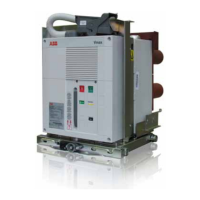47
Description of figures
Fig. 1 = Spring charging-motor circuit (see note C).
Fig. 2 = Shunt closing release (antipumping is achieved
mechanically).
Fig. 3 = Locking magnet. If de-energized it prevents the
circuit-breaker closing mechanically (this fig. must
be given when is request -RL1 and fig. 31 or 32
is selected). (It is possible to limit its consumption
by connecting in series a delaying pushbutton
enabling the operation).
Fig. 4 = Locking magnet. If de-energized it prevents the
circuit-breaker closing mechanically (this fig. must
be given when is request -RL1 and fig. 33 or 34 is
selected ). (It is possible to limit its consumption
by connecting in series a delaying pushbutton
enabling the operation).
Fig. 5 = Instantaneous undervoltage release (see note B).
Fig. 7 = First shunt opening release circuit with possibility
of permanent supervision of coil continuity (see
note D).
Fig. 8 = Locking magnet. If de-energized it prevents
the circuit-breaker racking-in and racking-out
mechanically (it is possible to limit its consumption
by connecting in series a delaying pushbutton
enabling the operation).
Fig. 9 = Second shunt opening release circuit with
possibility of permanent supervision of coil
continuity (see note D).
Fig. 10 = Opening solenoid for release external to the circuit-
breaker.
Fig. 26 = Contact signalling closing spring charged and
discharged (see note H).
Fig. 31-32-33-34 =Circuit-breaker available auxiliary contacts.
Fig. 51 = Contacts signalling circuit-breaker in the
connected and isolated positions located on the
circuit-breaker (when is request fig. 31 or 32 is
obbligatory).
Fig. 52 = Contacts signalling circuit-breaker in the
connected and isolated positions located on the
circuit-breaker (when is request fig. 33 or 34 is on
request).
Fig. 60 = Contact signalling undervoltage release deactivate.
Incompatibility
The combinations of circuits given in the figures below are not
possible on the same circuit-breaker:
3-4 31-31-33-34 4-31-32
3-33-34 – 31-32-52
33-34-51 51-52
Notes
A) The circuit-breaker is delivered complete with the
accessories listed in the ABB order acknowledgement only.
To draw up the order examine the catalogue.
B) The undervoltage release is available in the version suitable
for circuit-breaker supply side feeding or for feeding from
an independent source. Circuit-breaker may be closed only
if the undervoltage release is energized (lock on closing
is achieved mechanically). In case of the same voltage
supply for closing and undervoltage releases and if it is
required the circuit-breaker automatic closing when the
auxiliary voltage supply restores, it is necessary to delay
the energization of the closing release by 50 ms after the
undervoltage release acceptance.
C) Check the power supply available on the auxiliary circuit
to verify if it is adequate to start several closing spring-
charging motors simultaneously. To prevent excessive
consumption the closing springs must be charged manually
before energizing the auxiliary circuit.
D) The circuit for the supervision of shunt opening release coil
continuity shall be used for this function only.
E) Contacts signalling circuit-breaker in the connected and
isolated positions (-BT1 and -BT2) given in fig. 51 or 52
are located on the circuit-breaker (moving part) and are
available at request.
F) Fig. 3 is given when are requested fig. 31 or 32 , fig. 4
when are requested fig. 33 or 34 (in this case -BT3 is
obligatory).
G) When fig. 10 is requested contact -BB3 31-32 given
in fig. 32-34 is not available. When fig. 30 is requested
contact -BB3 53-54 given in fig. 32-34 is not available.
When fig. 9 is requested, contact -BB1 43-44 given in
fig. 31-32-34-34 is not available.
H) Both limit switches signalling must be working at the same
supply voltage.

